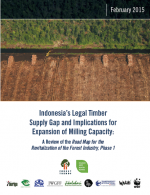Indonesia’s Legal Timber Supply Gap and Implications for Expansion of Milling Capacity
A Review of the "Road Map for the Revitalization of the Forest Industry, Phase 1
View PublicationIn 2007, the Indonesian Ministry of Forestry (MoF) developed a Road Map for the Revitalization of the Forest Industry that aimed, in part, to tackle the sector’s two major problems: 1) an insufficient supply of raw material; and, 2) an over-capacity in processing. As the first phase (2007-2014) of the Road Map draws to a close, this
paper evaluates whether the Indonesian forestry sector has a sufficient supply of legal timber to meet its growing demand for wood.
Reports published by the MoF indicate that since 1978, large processors (those consuming more than 6,000 m3 of wood per year) have used the equivalent of more than a billion cubic meters (m3) of wood as value-added plywood processing began dominating the industry in the 1980s, followed by pulp and paper in the 2000s. The pulp and paper sector reportedly now uses about 80 percent of the raw material consumed by large industry
in Indonesia. To feed the pulp sector, the MoF reports an increase in both the area planted and the wood used from industrial forestry plantations (Hutan Tanaman Industri, or HTI in bahasa Indonesia). Most (62 percent) of the HTI area is reportedly planted on the island of Sumatra. Given that more than 90 percent of pulp mill
capacity is located on Sumatra it is not surprising that 91 percent of the HTI-grown wood was reportedly used in pulp mills in Sumatra. However, the analyses in this paper which rely on government and forest-industry data only indicate that large operators are consuming more wood than the MoF reported as being legally
produced (in 2014, there was a gap of more than 30 percent). Presumably this gap continues to be met by an unregulated, and therefore illegal, wood supply.
The analyses also suggest, however, that the MoF underestimates the scale of the problem. For example, the pulp industry itself (Indonesian Pulp and Paper Association [Asosiasi Pulp dan Kertas Indonesia (APKI)]) consistently reported almost twice the production levels as the MoF. Moreover, timber use by small operators is not reported fully by the MoF, nor does the MoF estimate losses due to smuggling both of which are likely substantial.
Further, there are serious concerns about the plausibility of the MoF data. While HTI use reportedly increased more than tenfold in the decade between 1999 and 2008, the area reported as planted in the previous decade was actually declining. To compound this problem, the plantation sector, more broadly, has failed to achieve
the target for production set in the MoF’s Road Map. In the first phase of the Road Map, the plantation sector has under-performed; the MoF expected HTIs to have produced 46 percent more than industry reported used.

